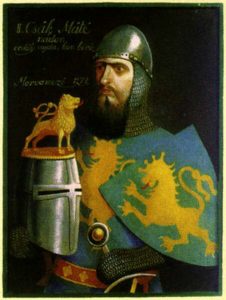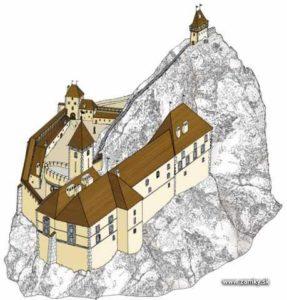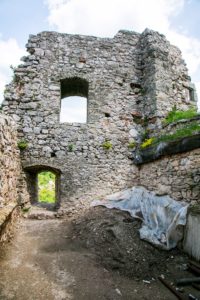Lednic

The ruins of Lednic (Lednica) Castle stand on a picturesque rocky ridge in the White Carpathians, in Slovakia. The first mention of the settlement is found in the 1259 charter of a certain land grant of Dulow, issued by Hungarian King Bela IV. At that time, the owner was Comes Márk of the Csák Clan: “comitem Mark de Lednych”.

He may have been the builder of the castle between 1259 and 1262. Later it became the property of Csák Máté, whose castle-mayor Ládi Pál was mentioned in 1310. The castle was mentioned in a charter of Csák Máté issued in 1316 in Beckó under the name “Lednuche”.

In this document, Palatine Matheus (Máté) ordered Albertus to send his son Kassa (Kasza) to the districts of Oroszlánkő, Lednic, Vágbeszterce, Hricsó, Litva, and Sztrecsén. Matheus was supposed to collect a certain amount of oats and a cart of hay and transport it to Trencsén castle at once. It became a royal castle after the death of Csák Máté in 1321.

In 1325, Köcski Sándor, the governor of the country, named himself castellan of “Beszterce [Vágbeszterce] and the other castles around it”. From 1326, Lackfi István, the stablemaster, was given the right of ownership, and his castellan of “Lednicza” in 1336 was a certain Chokaday.

In 1341, according to the charters of the Várad castle, Orros Miklós magister was the castellan of Lednic (“Ledneche / Legnyche / Legniche”) (* this does not mean Lednic in Trencsén County, according to several researchers). His son mortgaged it to a Czech named Henk sometime before 1392. In 1392, King Zsigmond (Sigismund) of Luxemburg granted permission to Kaplai Dezső (Kapolyai) to redeem it from Henk.

Around 1403, King Zsigmond, the monarch of Hungary pledged it to the brothers Kornicei Sobek and Matej Biliks (Bielik Vencel and Szobek) in Silesia for 3000 Prague “garas” (silver coin). In November 1432, invading Bohemian Hussites took Lednic and plundered the area from there. Their rule lasted until 1434.

After 1440, the lords of Lednic supported the widowed Queen Elizabeth in the internal war against the followers of King Ulászló. In 1444 it was mentioned as a fortress on the side of Giskra. In 1454, Governor Hunyadi János bought back several castles in Trencsén County for 13,000 gold forints from Cillei Ulrik. The Bielik family of Lednic probably also surrendered to the governor.

On 15 March 1458, King Matthias donated the castle of Beszterce in Trencsén County to Podmaniczky László for the services he rendered to the country and the Hunyadi family, and for the 12,000 forints he owed to Hunyadi László. According to the charter, Lednic (“Lednicze”) was also a part of the Beszterce castle’s manor (the title did not change in 1471).

However, Podmaniczky only owned the castle on paper, it was in the hands of the Bielik and the Nehéz families. In 1465, King Matthias, at the request of Bielik Vencel (“Venceslai Byel de Lednycze”), granted a coat of arms to the market town of Lednic.

https://hungarianottomanwars.myspreadshop.com/all
In 1475, the pledge was transferred to Nehéz Péter of Korompa and Sárosfalva, which King Matthias acknowledged in his charter of 14.07.1475 and left in their possession until the king paid them over 6,000 gold forints, which Nehéz had paid to Bielik Vencel for the castle of Lednic (“Castro Lednycz”). To complicate matters, a document from 1466 is known in which Nehéz Péter and Simon mortgaged Lednic’s castle and its toll to Podmaniczky László of Podmanin for 3,000 forints.

In 1504, a lawsuit was fought between Podmaniczky János and the widow of Nehéz Péter of Korompa over Lednic’s pledge. On 4 March of that year, King Ulászló II donated the castle of Lednic in Trencsén County, which had been pledged to Nehéz Péter and later to his widow, to Podmaniczky János, together with its appurtenances. This was opposed by Marcibányi András of Puchó, Zsófia, widow of Nehéz Péter of Korompa, and Potentiana, daughter of Nehéz György.

Litigation between the parties continued for years. However, in 1504, the widow sold the pledge of Lednic to Ráskai Balázs, the store master of the castle, who held it until 1515. The Podmaniczky family tried to assert their rights to the castle but without success. On 15 Jan. 1507, the convent of Túróc reported to King Ulászló II that, according to the king’s order of the previous year, they wanted to introduce Podmaniczky János, the chief chamberlain, into the possession of Lednic Castle (‘castri Lednycze’) and its appurtenances, but the introduction was opposed by Ráskai Balázs, the store master.

From 1515 to 1526 it was owned by Sarkány Ambrus of Ákosháza, who bought it from Ráskai Balázs for 8,000 forints. He wrote a letter on 16 Augustus 1522 from here to the city of Pozsony (Pressburg, Bratislava), and in the same year, he bequeathed it to his wife. In 1525 he also received a letter of donation from King Louis II, thus changing the status of the pledged property.

After the fateful Battle of Mohács in 1526, the Podmaniczky brothers switched from the side of King Ferdinand I to that of King Szapolyai in 1529 (interestingly, their relative, Bishop Podminiczky of Nyitra crowned Szapolyai János and later Ferdinand I as king). From their castle in Vágbeszterce, they plundered the estates of the Habsburgs and fought a separate war with Kosztka Miklós, the lord of Árva, Sztrecsén, and Zsolnalitva castles, who was also a pro-Szapolyai.

In 1530 Ferdinand sent Katzianer to subdue the robber knights of Podmaniczky, who then switched to the Habsburg side. In 1535, they returned to the side of Szapolyai and captured the castles of Hricsó and Lednic. It was then that they actually gained possession of the castle. For this campaign, they received the castle of Palota from King Szapolyai.

After the death of Podmaniczky Rafael in 1558, the castle reverted to the king. On 2 June 1559 King Ferdinand I donated it to Thelekessy Imre, the chief captain of Kassa. It then included 26 villages. With the tacit agreement of his grandson, Thelekessy Mihály, the cattle overseer of Lednice, the lord of the manor, Moncsek József, organized a band of plunderers from Lednic Castle in the last years of the 16th century. Later, according to the indictment, Thelekessy also participated in the robberies.

The Article XII of the Law made in 1600 named one of his crimes: “Furthermore, as the holy imperial and royal majesty complains with the most grievous complaint that he, Thelekessy Michael of Debrethe and Lednice, a few days ago, without regard to the public peace and the free refuge offered by his majesty, with his few soldiers and serfs, without the King’s knowledge, violently and plunderously attacked His Majesty’s carts from Transylvania with armed hands, and took away, carried off and made a prey of His Majesty’s movable goods in those carts, together with certain letters of different kinds. ” On 26 Dec. 1600, Thurzó György arrested Thelekessy at Biccse and after the trial, he was executed on 3 Apr. 1601. His property became the property of the king.

In 1601, Emperor Rudolf sold the Lednice manor to Dobó Ferenc of Ruszka, the son of the hero of Eger, for 140,000 forints. Many people protested against this, including Sárkány Miklós of Ákosháza. By the hand of Ruszkai Dobó Anna’s granddaughter, Zeleméri Kamarás Borbála, the estate passed to Lórántffy Mihály. In 1616 it was his daughter, Lórántffy Zsuzsanna, who gave it to Prince Rákóczi I György. In 1621, we know from a letter from Prince Bethlen Gábor of Transylvania that Rákóczi György had 400 infantrymen on standby at his Lednic estate. In 1624, after the defeat at the Battle of Fehérhegyi, Rákóczi settled the fleeing Czech-Moravian Protestants (“exiled brothers”) here.

During the 30-year war, the Rákóczi estates were the targets of the imperial troops. In Lednic, Hodossy Ferenc was Rákóczi’s castellan, who often informed the prince. In the spring of 1644, Lednic was surrounded by 2,000 Germans, but they soon withdrew from the castle. On 14 October 1644, Prince Rákóczi I György of Transylvania wrote to his wife, Lórántffy Zsuzsanna that Palatine Esterházy Miklós was besieging Lednic: “that the Palatine is contesting Lednic, even if he has not taken it, we cannot help it, having lost Murány because of the carelessness, and the bad young mind and drink of Illésházy Gábor.” Finally, in 1645, the Palatine treacherously seized the castle of Lednic, which was returned to Rákócz after the Treaty of Linz.

In 1659, Prince Rákóczi I György’s widow, Lórántffy Zsuzsanna left Lednic to her sons, or in case of their death without inheritance to the Zeleméri family.

In 1670, during the Wesselényi conspiracy, Prince Rákóczi I Ferenc launched a short-lived uprising and captured the castle of Tokaj. Zrínyi and Frangepán, who arrived in Vienna, were arrested by the court and Chancellor Lobkowitz had Zrínyi Péter (Petar Zrinski) write a letter to Rákóczi to stop the uprising. Rákóczi and the nobles of the Highlands stopped the fight. Zrínyi, Frangepán, and Nádasdy were beheaded, while Rákóczzi was saved from the execution by his mother under severe conditions. Emperor Leopold also confiscated the castle of Lednic on 23.04.1670.

A manuscript hymnal of the Lutheran pastors Coledanus János and Palumbini Sámuel from 1689 noted that the composers wrote their works in the prison of Lednic Castle, in heavy iron. In 1694, Prince Rákóczi II Ferenc and his sister Julianna pledged the Lednic estate to Zichy István for four years. In 1699 they divided the estates, but Lednic remained joint.

The titles of Prince Rákóczi II Ferenc included the title of hereditary lord of Lednic (“Nos Princeps Franciscus Rákóczy de Felső-Vadász, comes de Sáros, dux Munkátsiensis et Makoviczensis, arcium, dominiorumque Sáros-Patak, Tokaj, Regécz, Ecsed, Somlyó, Lednicze, Szerents et Ónod haereditarius Dominus, etc.”).

After the outbreak of the Rákóczi War of Independence in 1704, the castle fell into the hands of the anti-Habsburg Kuruc troops. In the autumn of 1707, after Ocskay’s successful raid on Beckó, he fortified the small castles still in the hands of the Kuruc soldiers. These castles were Lednic, Kaszavár, Oroszlánkő, Vág-Beszterce, Biccse, Budatin, Óvár, and Lietava castles. Except for Óvár, he found the castles in a very neglected state and almost empty.

From Érsekújvár Esterházy Antal sent 300 Hajdú soldiers and 8 howitzers to these castles under the command of Winkler Vilmos. According to Winkler’s reports written at the end of October, he found the castles unprepared. Lednic did not even have a rod to load the cannons, Beszterce was short of water – he asked for miners to clean the well. In Lietava, too, the well had to be cleaned out. Here the workers found 12 German prisoners who had been prisoners in the well for 2 years.

Winkler wrote a report about the fortification of Lednic: “In the castle of Lednicze, there is a clear, solid stone in the form of a bastion, which can be climbed up on a stone grid cut out of the upper castle, on which I have also put a small howitzer, and I have fenced the whole castle with palisades, having thrown down the useless wooden buildings in the lower castle, as they can meet the enemy from there.” He provided the castle with sufficient guards, food for two months, salted and smoked meat, ammunition, etc.

In the spring of 1708, the French military engineer De la Motte toured the fortresses on Rákóczi’s orders. He mainly examined the artillery and supplies, but the question of which of the small border castles was worth guarding was also raised. The report says that nearby Oroszlánkő only needs food, and a 30-man guard could protect it for years. He wrote the same about Lednic. Biccse, on the other hand, is not a defensible place, its occupation depends only on the enemy.

After the battle of Trencsén on 3 August 1708, Ottlyk tried to bring the small castles of Trencsén County from Lednic to Lietava into a defensible state. Bogády Andráswas the Kuruc commander in Lednic and the garrison must have numbered 80-100 Hajdú soldiers.
In October 1708, the Ebergényi Division under Pálffy’s command with the traitor Ocskay captured Bajmóc castle, and after the betrayal of Colonel Thuróczy Gáspár, Zsolna and Budatin were taken as well. Pálffy’s troops captured Vágbeszterce and Lednic. Bogády wrote to Ottlyk about Lednic on 20 November, so at that time the castle was still in Kuruc’s hands (“Here, the commander of Trencsén, Morelli, is trying to tempt us with threats and promises to turn us into traitors and corrupt us…”). In the end, General Hochperg sent siege cannons under the castle and the defenders were forced to surrender in early December 1708.

After 1711, it was acquired by the Aspermont-Lynden family (Prince Aspermont was Rákóczi Julianna’s husband). In 1724 it was mortgaged by Mattyasovszky György. On 24 June 1754, a document was drawn up with a detailed description of the “Arx Ledniczensis”. According to this, the Mattyasovszky family restored the castle in 1746. In front of the castle, there was a poorly kept garden, from here the entrance to the outer castle is via a trapdoor consisting of a tower. In this tower, there was the guards’ room and a dungeon. The roofs in this part of the castle were new.

According to a charter of 17 May 1768, if the lord of the manor was present, the villagers were obliged to post a guard in the castle day and night. The other villages of the manor were obliged to repair the castle and transport hay from the landlord’s barns to the castle. Lednic Manor was a fief and Aspermont manor at this time. The castle was two stories high and built on a rock, according to the report.

Around the end of the 18th century, the castle was abandoned and began to deteriorate. Mednyánszky Alajos visited it in 1825 and described it as a ruin: “Eighty stairs are cut into the cliff that leads up to the main bastion of the fortress: this part needs to be preserved but the other side was taken care of by nature. But apart from the bastion and a spacious casemate, whose vaults are worth admiring, there is nothing special to be found in the castle ruins. “

Divald Kornél wrote about the castle in the early 1900s: ‘A spacious walled courtyard, a citadel built on a rock on the north side, with a 10 m long corridor cut into the rock, leading to it through a cylindrical bastion jutting out of the rock face. The last in the irregularly arranged series of smaller and larger rooms in the citadel is the rectangular old tower, from which a passage cut into the rock on the ridge of the hill leads to the rocky outcrops projecting from the castle’s perimeter wall. At the top of the latter is a walled watchtower.”

Between 1960 and 1962 there was a partial conservation. Today, work is still ongoing on the castle, so it can only be visited for a limited period on weekdays (2022).

Source: http://www.varlexikon.hu
Dear Readers, I can only make this content available through small donations or by selling my books or T-shirts:
Please, feel free to support me with a coffee here:
You can check out my books on Amazon or Draft2Digital, they are available in hardcover, paperback, or ebook:
https://www.amazon.com/dp/198020490X or at https://books2read.com/b/boYd81

My work can also be followed and supported on Patreon: Become a Patron!http://Become a Patron!

Here are more pictures of Lednic Castle:
You can Adopt A Castle to help my work:















































